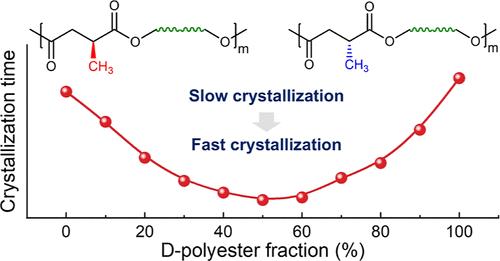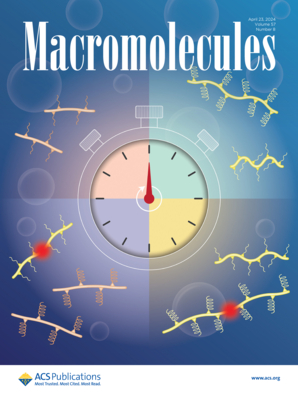长间距手性聚酯对映体混合物的加速结晶和热稳定晶相的优先形成
IF 5.1
1区 化学
Q1 POLYMER SCIENCE
引用次数: 0
摘要
L 型和 D 型手性聚合物的对映体混合物通常表现出与相应的对映体纯聚合物截然不同的结晶行为和物理性质。然而,人们对 L 型和 D 型聚合物对映体混合物的结晶动力学和结晶结构还不甚了解,尤其是对低手性分子密度的手性聚合物。在此,我们合成了一系列手性分子含量相对较低的长间距手性聚酯,并研究了对映体共混对手性聚酯结晶动力学和晶体多态性的影响。与其他手性分子含量较高的手性聚酯不同,长间距手性聚酯的对映体混合物不会结晶成新的立体复合物晶体,但其结晶速度比相应的对映体纯聚酯快。与对映体纯聚酯相比,对映体混合物在冷却过程中更容易形成热稳定的 I 型晶体,在等温结晶过程中生成 I 型晶体的温度范围更广。随着手性分子含量的减少或亚甲基间隔长度的增加,对映体共混物对结晶的影响变得不那么明显。我们推断,在对映体共混物中加速结晶和促进形成 I 型晶体与 L 型和 D 型聚酯之间的链间相互作用有关。这项研究为了解长间隔手性聚酯的结晶提供了新的视角。本文章由计算机程序翻译,如有差异,请以英文原文为准。

Accelerated Crystallization and Preferred Formation of a Thermally Stable Crystal Phase in Enantiomeric Blends of Long-Spaced Chiral Polyesters
Enantiomeric blends of L- and D-type chiral polymers usually show distinct crystallization behavior and physical properties from the corresponding enantiopure polymers. However, the crystallization kinetics and crystalline structure of the enantiomeric blends of L- and D-polymers are not yet well understood, particularly concerning the chiral polymers with low chiral moiety densities. Herein, we synthesized a series of long-spaced chiral polyesters with a relatively low chiral moiety content and investigated the effects of enantiomeric blending on the crystallization kinetics and crystal polymorphism of chiral polyesters. Different from the other chiral polyesters with high chiral moiety content, the enantiomeric blends of long-spaced chiral polyesters do not crystallize into the new stereocomplex crystals but have a faster crystallization rate than the corresponding enantiopure polyesters. Compared to the enantiopure polyesters, the enantiomeric blends show the preferred formation of thermally stable form-I crystals in the cooling process and the broader temperature range for generating the form-I crystals in isothermal crystallization. The effects of enantiomeric blending on crystallization become less obvious with decreasing the chiral moiety content or increasing the methylene spacer length. We infer that the accelerated crystallization and facilitated formation of form-I crystals in enantiomeric blends are correlated with the interchain interactions between L- and D-polyesters. This study provides new insights into the crystallization of long-spaced chiral polyesters.
求助全文
通过发布文献求助,成功后即可免费获取论文全文。
去求助
来源期刊

Macromolecules
工程技术-高分子科学
CiteScore
9.30
自引率
16.40%
发文量
942
审稿时长
2 months
期刊介绍:
Macromolecules publishes original, fundamental, and impactful research on all aspects of polymer science. Topics of interest include synthesis (e.g., controlled polymerizations, polymerization catalysis, post polymerization modification, new monomer structures and polymer architectures, and polymerization mechanisms/kinetics analysis); phase behavior, thermodynamics, dynamic, and ordering/disordering phenomena (e.g., self-assembly, gelation, crystallization, solution/melt/solid-state characteristics); structure and properties (e.g., mechanical and rheological properties, surface/interfacial characteristics, electronic and transport properties); new state of the art characterization (e.g., spectroscopy, scattering, microscopy, rheology), simulation (e.g., Monte Carlo, molecular dynamics, multi-scale/coarse-grained modeling), and theoretical methods. Renewable/sustainable polymers, polymer networks, responsive polymers, electro-, magneto- and opto-active macromolecules, inorganic polymers, charge-transporting polymers (ion-containing, semiconducting, and conducting), nanostructured polymers, and polymer composites are also of interest. Typical papers published in Macromolecules showcase important and innovative concepts, experimental methods/observations, and theoretical/computational approaches that demonstrate a fundamental advance in the understanding of polymers.
 求助内容:
求助内容: 应助结果提醒方式:
应助结果提醒方式:


